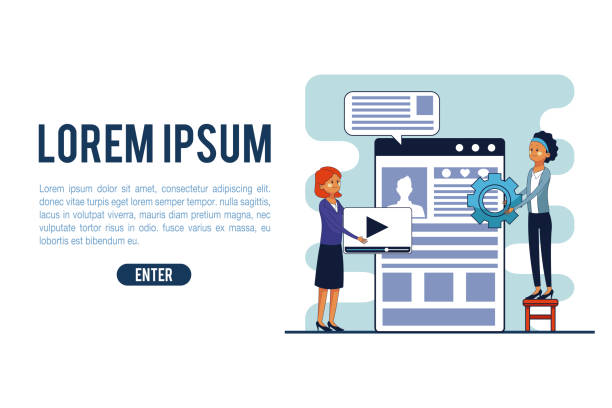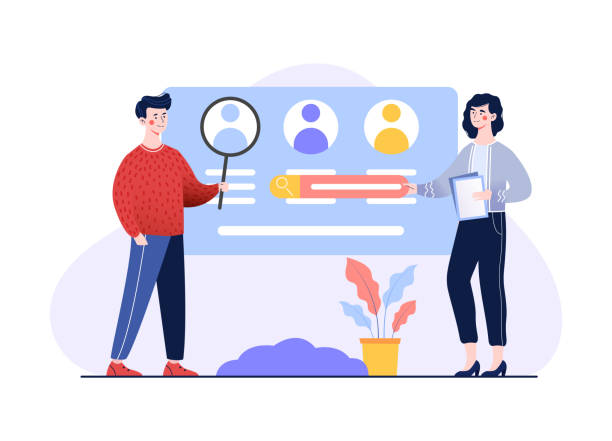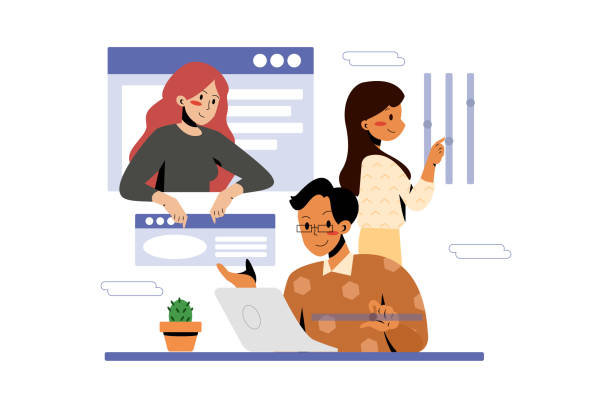An Introduction to Multilingual Website Design and Its Importance in the Current Era

In today’s world, where geographical boundaries have lost their meaning in the digital space, multilingual website design is no longer a luxury option, but a necessity for any business that dreams of reaching global markets.
The importance of #multilingual_website_design lies in enabling businesses to convey their message in the native language of international audiences, establishing a deeper and more effective connection.
This approach not only increases accessibility and visibility but also significantly boosts user credibility and trust.
Imagine a German, Japanese, or Spanish user visiting your website and being able to find all the information they need in their own language; this user experience will undoubtedly lead to greater loyalty and higher conversion rates.
Monolingual websites, especially in today’s competitive markets, are unable to fully capitalize on global potential.
They limit themselves to specific audiences and miss countless opportunities for growth and development.
Therefore, if you are looking for a stronger presence in the global market, investing in multilingual website design is considered an essential and strategic step.
This is a strategic decision that will revolutionize your business’s digital future.
Are you tired of losing business opportunities due to not having a professional corporate website?
Rasaweb helps you with professional corporate website design:
✅ Build a powerful and reliable brand image
✅ Convert website visitors into loyal customers
⚡ Get a free consultation now!
Undeniable Advantages of Multilingual Website Design in SEO and User Experience

The benefits of multilingual website design are not limited to increased accessibility; this approach has profound effects on Search Engine Optimization (SEO) and User Experience (UX).
From an SEO perspective, having multiple versions of a website in different languages helps search engines index your content for local and international searches.
This means your chances of appearing in search results for users in different countries significantly increase.
Using hreflang tags, which tell search engines that different versions of a page exist for specific languages and regions, is crucial for this purpose.
This prevents the «duplicate content» issue and ensures the SEO credibility of each language version.
Furthermore, when users find your content in their own language, their Dwell Time on the site and reduced Bounce Rate improve, which are important positive signals for search engine rankings.
From a user experience standpoint, providing content in the native language creates a sense of comfort and reassurance.
This not only makes users spend more time on the site but also significantly increases the likelihood of #conversion (purchase, registration, contact).
Multilingual website design ultimately means providing a personalized and culture-centric experience that builds a strong bridge between your business and your global customers, paving the way for sustainable growth.
Technical Challenges in Designing and Implementing Multilingual Websites

Implementing multilingual website design comes with numerous technical challenges that require precise planning and specialized knowledge.
One of the most important challenges is content and translation management.
Ensuring that all content is accurately and correctly translated, and consistently updated, is a difficult task.
Also, the issue of Right-to-Left (RTL) and Left-to-Right (LTR) languages arises; for languages like Persian or Arabic, the design must be displayed from right to left, while most languages are left to right.
This issue can affect the Layout and User Interface (UI) design.
Unicode and character encoding are also of high importance to ensure that all letters and characters of different languages are displayed correctly without issues.
Text direction and setting the Language header at the HTTP level are other important technical considerations.
Below, a comparative table of different approaches to multilingual content management is provided, which can offer a specialized perspective for choosing the right solution in multilingual website design.
| Approach | Advantages | Disadvantages |
|---|---|---|
| Subdomain | Easy regional SEO management, separate servers | Requires separate maintenance, potential slowdown in loading |
| Subdirectory | Stronger SEO for the main domain, centralized management | Complexity in large-scale scalability, interference with root files |
| URL Parameter | Simple implementation, short URLs | Potential SEO issues (duplicate content), less user-friendly |
Choosing the Right Content Management System for Multilingual Design

Choosing an efficient Content Management System (CMS) plays a key role in the success of multilingual website design.
A suitable CMS should have native capabilities for language and translation management or provide this functionality through plugins and modules.
WordPress, with plugins like WPML or Polylang, is one of the most popular options for multilingual websites, offering high flexibility and supported by a large user community.
Drupal is also an excellent option for larger and more complex projects due to its powerful core and native multilingual capabilities.
For businesses with specific and unique needs, developing a custom CMS might be the best solution, although this approach will involve higher costs and development time.
When choosing a CMS, pay attention to these points: ease of content translation, ability to manage images and media for each language, automatic support for hreflang tags, and native SEO capabilities for each language.
Also, #system_security and its developer community are important factors.
An unsuitable CMS can turn the multilingual website design process into a nightmare, while the right choice facilitates the workflow and prevents additional costs in the long run.
This choice is a strategic decision that directly impacts your website’s performance and maintenance.
Are you tired of losing business opportunities due to not having a professional corporate website?
Rasaweb helps you with professional corporate website design:
✅ Build a powerful and reliable brand image
✅ Convert website visitors into loyal customers
⚡ Get a free consultation now!
Advanced SEO Strategies for Multilingual Websites

For your multilingual website design to perform well in search engines, you need advanced SEO strategies beyond mere content translation.
One of the most important strategies is the correct use of the `hreflang` tag.
This tag tells search engines like Google that different versions of a page exist for specific languages or regions, and this helps prevent duplicate content issues.
Furthermore, local keyword research for each language and region is vital.
Words that are popular in one language or culture may not have the same meaning or popularity in another.
Therefore, separate keyword research should be conducted for each language version, and content should be optimized accordingly.
URL structure also matters; using subdirectories (e.g., yourdomain.com/en/ and yourdomain.com/fa/) or subdomains (e.g., en.yourdomain.com and fa.yourdomain.com) are the most common methods, each with its own advantages and disadvantages.
Search engines recognize these structures well.
Also, acquiring backlinks from reputable websites in each country or language region can significantly boost your SEO credibility.
Don’t forget that #site_loading_speed and responsive design for all languages and devices are fundamental SEO principles that must be carefully observed.
By implementing these strategies, you can ensure that your multilingual website reaches its maximum potential in attracting organic traffic.
User Experience and Cultural Factors in Multilingual Website Design

Beyond translating words, successful multilingual website design requires a deep understanding of cultural differences and their importance in User Experience (UX).
A visual design or a writing tone that is accepted in one culture may be considered inappropriate or even offensive in another.
Therefore, it is necessary that images, colors, symbols, and even page layouts be localized with attention to the cultural sensitivities of the target audience.
For example, the color red symbolizes danger in some cultures and good luck in others.
The text layout (right-to-left or left-to-right) and the format of date and time, phone numbers, and addresses should also be adjusted according to the geographical region.
The placement of the language selection button is also very important; it should be easily accessible and visible.
Many websites place it in the top corner of the page, but its display method (flag, language code, or language name) can also affect user experience.
A well-localized multilingual website not only provides an accurate translation of content but also creates a sense of familiarity and comfort for international users.
This feeling encourages them to #interact more with the website and ultimately convert into customers.
Ignoring these cultural factors can nullify your efforts in multilingual website design and even lead to the loss of potential customers.
Therefore, these aspects must be addressed with careful consideration and research.
Content Management and Translation Processes in Large Multilingual Projects

One of the most complex aspects of multilingual website design is continuous content management and ensuring translation quality.
As the website expands and content increases, the use of Translation Management Systems (TMS) and Translation Memory (TM) becomes essential.
These tools help maintain terminological consistency, increase translation speed, and reduce costs in the long run.
Collaborating with native and specialized translators in your field of activity is crucial; machine translations (like Google Translate), although fast, often lack accuracy, cultural nuances, and appropriate tone for professional content and can damage your brand.
Creating a #specialized_glossary and a style guide for each language helps translators produce consistent, high-quality content.
Also, having a review and approval process for translated content before publishing it is vital.
This process should include grammatical, spelling, cultural, and SEO checks.
Here, you will find a comparative table of common content translation methods and their advantages and disadvantages, which can help you choose the appropriate approach for your multilingual website design project.
| Translation Method | Advantages | Disadvantages |
|---|---|---|
| Human Translation (Professional) | High quality, cultural understanding, SEO-friendly | High cost, time-consuming, requires project management |
| Machine Translation (MT) | High speed, low cost, suitable for non-sensitive content | Low quality, lack of cultural context, requires review |
| Machine Translation Post-Editing (MTPE) | Combines speed and quality, cost-effective | Still requires skilled translator, variable quality |
New Trends and the Future of Multilingual Website Design

The future of multilingual website design is rapidly evolving, with new trends emerging that need attention.
One of the most important trends is the use of Artificial Intelligence (AI) and Machine Learning (ML) in translation processes.
Neural Machine Translation (NMT) systems are now capable of producing much higher quality translations than in the past and can significantly increase the speed of the localization process.
However, human editing is still required to ensure accuracy and cultural appropriateness.
Also, with the increasing use of #voice_search, multilingual websites must prepare for this new platform.
Optimizing content to answer voice queries in different languages is a necessary step.
Virtual Reality (VR) and Augmented Reality (AR) also provide new potentials for delivering multilingual content in immersive experiences.
Web developers must prepare themselves to work with frameworks and tools that support these technologies.
Finally, with the emergence of new markets and increased #internet_connectivity in different parts of the world, the demand for multilingual websites that can serve diverse populations with different languages will only grow.
Internet user statistics show that English accounts for only a small fraction of global users.
Therefore, investing in multilingual web development is not only a current need but an investment for the future that enables businesses to be leaders in global markets and respond to the growing needs of audiences.
Is your current e-commerce website design causing you to lose customers and sales?
Rasaweb is your solution with modern and user-friendly e-commerce website designs!
✅ Significantly increase conversion rates and sales
✅ Build strong branding and gain customer trust
⚡ Get a free e-commerce website design consultation from Rasaweb now!
Common Mistakes in Multilingual Website Design and Solutions to Avoid Them

In the path of multilingual website design, there are common mistakes that can severely damage your website’s performance and credibility.
One of the biggest mistakes is relying solely on machine translation without human review.
As mentioned earlier, machine translations may not be accurate and may fail to convey cultural nuances and specific idioms correctly.
This can lead to clumsy and unprofessional content that undermines your brand’s credibility.
Another mistake is ignoring local SEO for each language.
Simply translating keywords is not enough; new keyword research should be conducted for each language, and content should be optimized accordingly.
Incorrect use of hreflang tags can also lead to duplicate content issues and reduced search engine rankings.
Also, many designers overlook #responsive_design for different languages and devices, which severely disrupts the user experience.
Another mistake is not considering cultural differences in visual design and messaging.
Colors, images, and even the display of contact information must be carefully localized.
Avoiding these common mistakes requires careful planning, hiring local experts, and using appropriate content management and translation tools.
By being vigilant and precise in these steps, you can prevent wasted capital and time and launch a successful and efficient multilingual website.
Are you ready to globalize your business?
Entertaining or Professional: How to Create Effective Multilingual Content

In multilingual website design, content is king, but not just any content.
Depending on your website’s purpose, content can have various aspects: from highly specialized and technical content to entertaining and engaging content.
The key is that content must be appropriate for the expectations and culture of the target audience in each language.
For example, a news website might require quick and updated news translations, while an entertainment blog might focus on jokes and cultural references that differ in each language.
Educational content must also be carefully translated to ensure complex concepts are accurately and understandably conveyed in different languages.
Using local examples and case studies can help improve the understanding of educational materials.
It is important that every type of content, whether explanatory, analytical, news, or even entertaining, maintains high quality and conveys a professional impression.
This includes adhering to grammatical, spelling, and punctuation rules for each language.
Understanding cultural differences in content production can help you accurately deliver the message you intend to your global audience.
Therefore, in multilingual site development, never overlook the importance of high-quality and localized content.
This investment will guarantee success and attract loyal audiences worldwide, providing accurate and comprehensive answers to user questions about your products and services.
Frequently Asked Questions
| Question | Answer |
|---|---|
| What is a multilingual website? | A website whose content is available to users in several different languages. |
| Why should we design a multilingual website? | To expand reach to international audiences, increase website traffic, improve SEO in target markets, and provide a better user experience for non-Persian speaking users. |
| What are the main methods for implementing a multilingual website? | Using subdomains (e.g., en.mysite.com), using subdirectories (e.g., mysite.com/en/), and using separate domains for each language (e.g., mysite.com and mysite.de). |
| Which implementation method is better for SEO? | Generally, using subdirectories (language folder) is often recommended due to the transfer of main domain authority to other languages. |
| What is the Hreflang tag and what is its use? | It is an HTML tag or HTTP Header that informs search engines which version of the page is suitable for which language or geographical region. This tag prevents Duplicate Content and improves SEO. |
| How is a Language Switcher designed? | Usually by using a dropdown menu, button, or flag in the header or footer of the site, which allows the user to select their preferred language. |
| Is automatic (machine) translation suitable for a multilingual website? | No, machine translation usually has low quality and many errors that can damage the site’s credibility. Human translation or a combination of human translation and machine post-editing is recommended. |
| What are the most important SEO tips for multilingual website design? | Correct use of Hreflang tag, suitable URL structure for each language, translation of title and meta descriptions, translation of main content, internal linking between related language versions. |
| Should all website content be translated? | It depends on the strategy. Usually, the main and important content of the site should be translated. Less important sections or blogs may not require full translation. |
| What are the main challenges in multilingual website design? | Managing content in different languages, translation costs, technical issues related to URLs and language tags, template compatibility with Right-to-Left (RTL) languages like Persian and Arabic, and managing multilingual SEO. |
And other services of Rasa Web Advertising Agency in the field of advertising
Smart UI/UX: Designed for businesses seeking to increase click-through rates through marketing automation.
Smart Customer Journey Map: A novel service to improve SEO ranking through user experience customization.
Smart Social Media: Revolutionize SEO ranking with intelligent data analysis.
Smart Advertorial: A creative platform to improve online growth with intelligent data analysis.
Smart Direct Marketing: Designed for businesses aiming for digital branding through optimizing key pages.
And over hundreds of other services in the field of internet advertising, advertising consultation, and organizational solutions
Internet Advertising | Advertising Strategy | Advertorial
Resources
The Importance of Multilingual Website Design for Businesses
International and Multilingual Website Design Services
Strategies for Global Business Expansion with a Website
Complete Guide to Multilingual Website SEO
? With Rasaweb Afarin, your business will be transformed in the digital world; from secure website design to targeted marketing, we are with you.
📍 Tehran, Mirdamad Street, next to Central Bank, Kazeroon Jonubi Alley, Ramin Alley, No. 6

